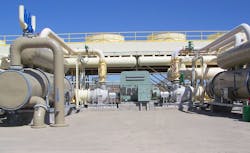California Clean Energy Aggregators sign 20-year PPA for Geothermal, recovered power
A group representing some of California’s Community Choice Aggregators (CCAs) for clean energy has signed a 20-year power purchase agreement with a geothermal provider.
Ormat Technologies Inc. will handle execution of the PPA with California Community Power, which is an agency consisting of several California CCAs. Those CCAs are empowered to contract for clean energy options in the generation mix.
The 20-year PPA will include new projects currently under construction or in development in California and Nevada. Energy deliveries are expected to begin in the second quarter of 2024.
Ormat Technologies’ portfolio includes geothermal, energy storage, solar PV and recovered energy power. The Company owns, operates, designs, manufactures and sells geothermal and REG power plants primarily based on the Ormat Energy Converter – a power generation unit that converts low-, medium- and high-temperature heat into electricity
“Ormat is thrilled to execute this portfolio PPA with CC Power and its members. This collaboration is another example of the benefits of geothermal as a reliable source of sustainable baseload energy,” said Doron Blachar, CEO of Ormat Technologies. “In addition to the latest two PPAs we recently signed with NV Energy, this twenty-year PPA will enable Ormat to continue executing upon our multi-year growth trajectory. We are very pleased to help the western states meet their renewable energy goals and believe geothermal offers a reliable alternative to baseload needs as the United States moves towards a more sustainable future.”
California Community Power made its initial request for clean energy resources last year, in response to regulator California Public Utilities Commission’s requirement that electricity distributors procure long-term low or zero-carbon resources to address mid-term reliability issues.
Geothermal plants currently provide less than five percent of the state’s energy mix, but even that is multiple times higher than the national average. California has dozens of geothermal production sites, many of those decades old.
The parent of Ormat Technologies began more than 50 years ago in Israel by a turbine engineer who also co-developed the organic Rankine cycle, which allows for heat recovery at a lower temperature than in steam generation.
-- -- --
(Rod Walton, senior editor for EnergyTech, is a 14-year veteran of covering the energy industry both as a newspaper and trade journalist. He can be reached at [email protected]).
About the Author
Rod Walton, EnergyTech Managing Editor
Managing Editor
For EnergyTech editorial inquiries, please contact Managing Editor Rod Walton at [email protected].
Rod Walton has spent 17 years covering the energy industry as a newspaper and trade journalist. He formerly was energy writer and business editor at the Tulsa World. Later, he spent six years covering the electricity power sector for Pennwell and Clarion Events. He joined Endeavor and EnergyTech in November 2021.
Walton earned his Bachelors degree in journalism from the University of Oklahoma. His career stops include the Moore American, Bartlesville Examiner-Enterprise, Wagoner Tribune and Tulsa World.
EnergyTech is focused on the mission critical and large-scale energy users and their sustainability and resiliency goals. These include the commercial and industrial sectors, as well as the military, universities, data centers and microgrids. The C&I sectors together account for close to 30 percent of greenhouse gas emissions in the U.S.
He was named Managing Editor for Microgrid Knowledge and EnergyTech starting July 1, 2023
Many large-scale energy users such as Fortune 500 companies, and mission-critical users such as military bases, universities, healthcare facilities, public safety and data centers, shifting their energy priorities to reach net-zero carbon goals within the coming decades. These include plans for renewable energy power purchase agreements, but also on-site resiliency projects such as microgrids, combined heat and power, rooftop solar, energy storage, digitalization and building efficiency upgrades.

